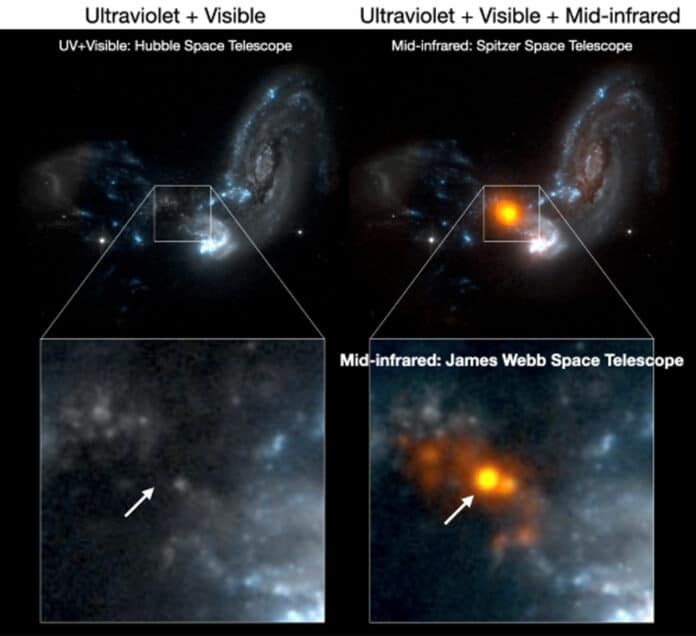Using JWST, the team has pinpointed the precise location of the “engine” of the merging galaxy IIZw096. Located almost 500 million light-years away, near the constellation Delphinus, IIZw096 is the site of a spectacular burst of star formation, hinted at in the red speckles near the middle of the image.
Corresponding author Hanae Inami, assistant professor at Hiroshima University‘s Hiroshima Astrophysical Science Center, said, “The James Webb Space Telescope has brought us completely new views of the universe thanks to it having the highest ever spatial resolution and sensitivity in the infrared. We wanted to find the ‘engine’ that powers this merging galaxy system. We knew that this source was deeply hidden by cosmic dust, so we could not use visible or ultraviolet light to find it. Only in the mid-infrared, observed with the James Webb Space Telescope, do we now see that this source outshines everything else in these merging galaxies.”
Stars, planets, and other galactic components may collide as they merge, providing material for new celestial events. Most of these galactic collisions only produce infrared light, which is invisible to humans and has longer wavelengths than visible light. The same team discovered that the merging system was dominated by infrared solid emission in 2010 using the Spitzer Space Telescope. The telescope’s poor resolution prevented the scientists from pinpointing the engine’s precise location, despite being able to measure the engine’s power as the cause of the light.
Co-author Thomas Bohn at Hiroshima University said, “With the James Webb Space Telescope, they found that this engine is responsible for the bulk of the mid-infrared emission, which accounts for up to 70% of the total infrared emission of the system. They also found that the source has a radius no larger than 570 light years — a tiny fraction of the size of the merging system, which is about 65,000 light-years across. This indicates that the energy is confined to a small space.”
“It is intriguing that this compact source, far from the galactic centers, dominates the infrared luminosity of the system.”
“This source contributes significantly to the merging galaxies despite lying in the outskirts, like a speck of pepper on the white of a fried egg.”
Inami asked, “We want to know what powers this source: is it a starburst or a massive black hole? We will use infrared spectra taken with the James Webb Space Telescope to investigate this. It is also unusual that the ‘engine’ lies outside the main parts of the merging galaxies, so we will explore how this powerful source ended up there.”
In addition to locating the engine, the researchers discovered 12 light “clumps.” Five of these were found for the first time using the James Webb Space Telescope. However, several of them had already been discovered by the Hubble Space Telescope’s near-infrared capabilities. According to Inami, these release mid-infrared light that could be the beginnings of stars.
Inami said, “The James Webb Space Telescope mid-infrared imaging described in this paper revealed a hidden aspect of the merging galaxy IIZw096 and opened a door towards identifying heavily dust-obscured sources which cannot be found at shorter wavelengths. Future planned spectroscopic observations of IIZw096 will provide additional information on the nature of the dust, ionized gas, and warm molecular gas in and around the disturbed region of this luminous merging galaxy.”
Journal Reference:
- Hanae Inami, Jason Surace, et al. GOALS-JWST: Unveiling Dusty Compact Sources in the Merging Galaxy IIZw096. The Astrophysical Journal Letters. DOI: 10.3847/2041-8213/ac9389
